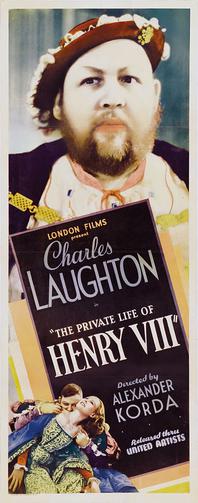| The Private Life of Henry VIII | |
|---|---|
 | |
| Directed by | Alexander Korda |
| Written by | Lajos Biró Arthur Wimperis |
| Produced by | Alexander Korda |
| Starring | Charles Laughton Robert Donat Merle Oberon Elsa Lanchester Franklin Dyall Miles Mander |
| Distributed by | United Artists |
Release date |
|
Running time | 97 minutes |
| Country | United Kingdom |
| Language | English |
The Private Life of Henry VIII is a 1933 film about Henry VIII, King of England. It was written by Lajos Biró and Arthur Wimperis, and directed by Sir Alexander Korda.
Charles Laughton won the 1933 Academy Award as Best Actor for his performance as Henry. The film was the first British production to be nominated for the Academy Award for Best Picture.
Plot
In May 1536, immediately following the execution of his second wife, Anne Boleyn (Merle Oberon), King Henry VIII (Charles Laughton) marries Jane Seymour (Wendy Barrie), who dies in childbirth eighteen months later. He then weds a German princess, Anne of Cleves (played by Laughton's real-life wife Elsa Lanchester). This marriage ends in divorce when Anne deliberately makes herself unattractive so she can be free to marry her sweetheart. (In an imaginative and high-spirited scene, Anne "wins her freedom" from Henry in a game of cards on their wedding night). After this divorce, Henry marries the beautiful and ambitious Lady Katherine Howard (Binnie Barnes). She has rejected love all her life in favour of ambition, but after her marriage, she falls in love with Henry's handsome courtier Thomas Culpeper (Robert Donat). Their liaison is discovered by Henry's advisers and the couple are executed. The weak and aging Henry consoles himself with a final marriage to Catherine Parr (Everley Gregg), who survives her husband.
Cast
- Charles Laughton as Henry VIII
- Merle Oberon as Anne Boleyn
- Wendy Barrie as Jane Seymour
- Elsa Lanchester as Anne of Cleves
- Binnie Barnes as Catherine Howard
- Robert Donat as Thomas Culpeper
- Franklin Dyall as Thomas Cromwell
- Miles Mander as Wriothesley
- Laurence Hanray as Archbishop Thomas Cranmer
- William Austin as The Duke of Cleves
- John Loder as Thomas Peynell
- Everley Gregg as Catherine Parr
Inaccuracy
Historically, the film is wildly inaccurate with the possible exception of the Anne Boleyn storyline at the beginning. It does not portray Henry's first (and longest) marriage to the Spanish princess, Catherine of Aragon, dismissing it quickly in the opening titles and ignoring the political and religious upheaval that followed the divorce. Jane Seymour did not die in childbirth, but twelve days after her son (Prince Edward) was born. There is no evidence that Anne of Cleves deliberately made herself unattractive to Henry; he annulled their marriage because he felt he had been misled about her appearance. Her motive for wanting an annulment, to be free to marry her true love, is entirely fictional, as Anne of Cleves never remarried, and converted, later in life, to Roman Catholicism. Katherine Howard was said to have had an affair with Francis Dereham before she came to court, in addition to committing adultery with Thomas Culpeper, and all three were executed. Catherine Parr is played for comic effect as an overbearing nag, history remembers her as a patient and loving wife. [citation needed]
Reception
It was hugely successful as a commercial film and it advanced Alexander Korda and Charles Laughton's careers. It was Merle Oberon's first major film role. Laughton would later reprise the same role in 1953 in the film Young Bess, opposite Jean Simmons as his daughter, Elizabeth. No other feature-length film would deal with all of Henry's wives until Henry VIII and his Six Wives in 1973. [citation needed]
It was the 12th most successful film at the US box office in 1933.[1]
See also
External links
- The Private Life of Henry VIII at IMDb
- The Private Life of Henry VIII at the BFI's Screenonline
- The Private Life of Henry VIII is available for free viewing and download at the Internet Archive
- The Private Life of Henry VIII at AllMovie
- The Private Life of Henry VIII at the TCM Movie Database
- The Private Life of Henry VIII review at Old Movies
- ^ itle=BOX OFFICE SUCCESSES OF 1933. |newspaper=The West Australian (Perth, WA : 1879 - 1954) |location=Perth, WA |date=13 April 1934 |accessdate=9 July 2012 |page=3 |publisher=National Library of Australia))